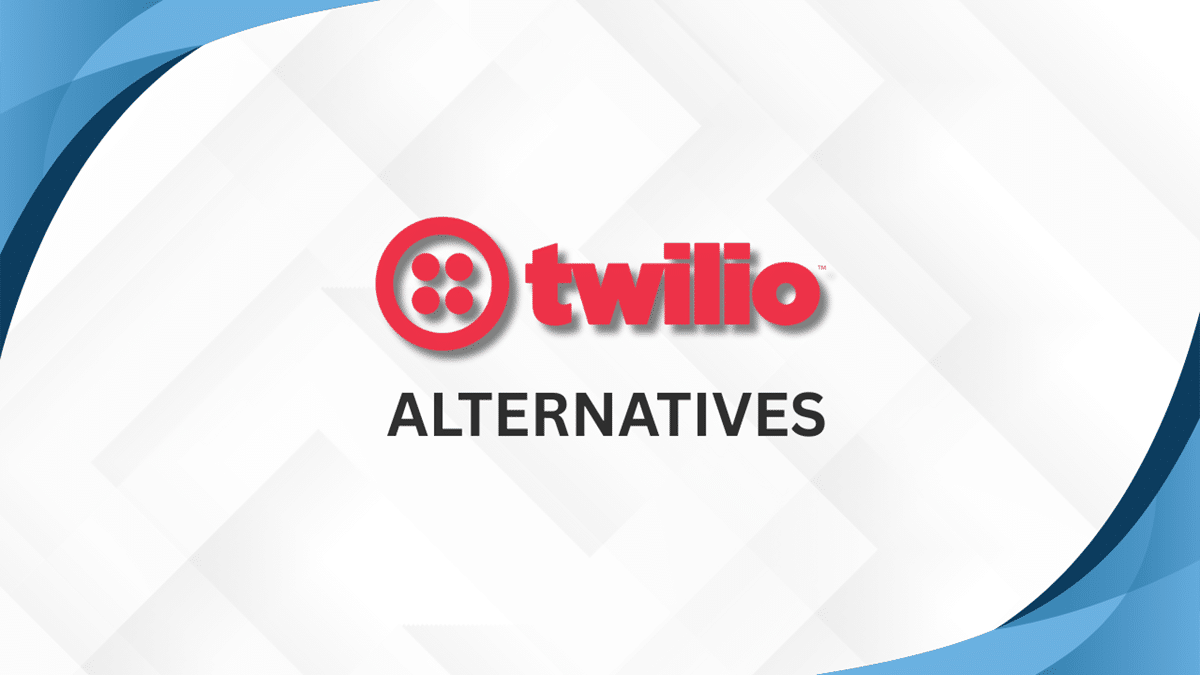
5 Best Twilio Alternatives for 2025 (Complete Review)
Grammarly’s State of Business Communication report shows workers spend 88% of their week on communication tasks. This causes stress for over half of employees and lowers productivity for many.
As businesses grow, the tools they rely on for messaging, calls, and other communication must be scalable, cost-effective, and easy to use.
Twilio is a platform that allows you to integrate calls, texts, and more into your apps. Its features make it a favorite among developers.
However, Twilio may not be the perfect solution for every business. For some, costs can be prohibitive, setup and usage too complex, or compliance with evolving regulations challenging.
In this article, we will explore five Twilio alternatives for 2025, highlighting their unique features, pricing structures, and areas of specialization that perfectly fit your requirements.
Why Consider Twilio Alternatives
As the needs of your businesses change, many are discovering that Twilio’s one-size-fits-all approach doesn’t always fit.
Challenges like unexpected costs, limited automation, and compliance hurdles with the latest 10DLC regulations drive companies to select the right Twilio for their operations.

Source: twilio.com
Here’s why businesses might look for Twilio alternatives:
- Cost: Twilio can be expensive, especially for small businesses or startups. Unlike others, Twilio charges for incoming messages, which may increase or even double costs.
- Ease of use: Some find the tool too complex, and companies prefer something easier to set up and use, especially if they don’t have a big tech team.
- Specific services: Certain businesses might need specialized features like advanced automated texting or better integration options that Twilio doesn’t prioritize.
- Automated texting and flexible API: Automated texting features are important for reaching out to customers effectively. A flexible API is also key to smoothly integrating the service with other business systems.
Compliance
Starting December 1st, 2024, U.S. phone carriers began blocking all unregistered 10DLC messaging.
Twilio users are encountering difficulties in this area, with many receiving rejections during the registration process and not getting enough support to resolve the issues.
This can lead to serious disruptions in their messaging capabilities and additional costs from penalties or surcharges for non-compliant messages. Downtime or missed opportunities can be costly.
5 Best Twilio Alternatives
There are other platforms that could be the right Twilio alternative, offering specialized features, competitive pricing, and tailored solutions to meet diverse business needs. Below, we explore five top alternatives to Twilio and what makes each one stand out.
1. Textellent
Textellent is a great alternative to Twilio, designed to make every interaction count by focusing on turning leads into customers and casual customers into loyal ones.
This SMS marketing software combines powerful automation, personalization, and performance tracking to help you see real results.
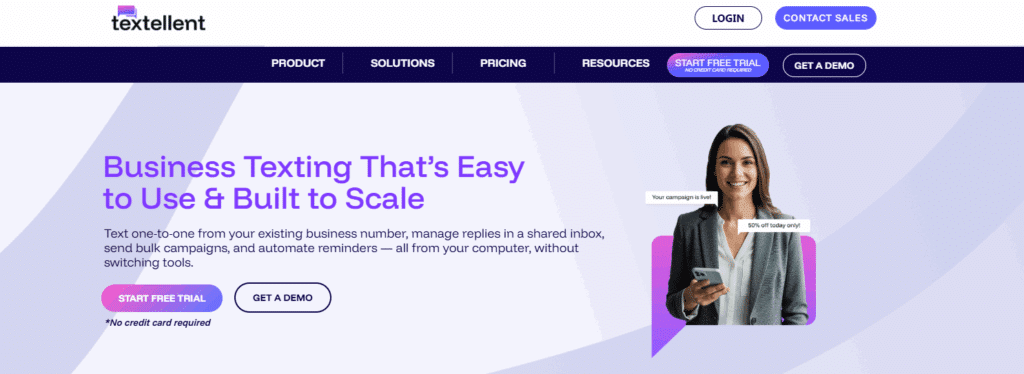
Here’s what makes Textellent the best alternative to Twilio:
Automated Drip Campaigns for Engagement
With Textellent, you can create campaigns that send personalized messages automatically based on customer actions or specific events.
After a customer asks for a quote, you can send a follow-up message immediately, then schedule a series of texts to guide them toward booking an appointment or making a purchase.
This process helps increase customer engagement and keeps your brand top of mind, which promotes proactive communication without overwhelming them.
Drip campaigns can also nurture long-term leads by sending helpful updates, appointment reminders, or special offers over time.
Personalized Campaigns That Feel Genuine
Textellent allows you to customize every message. Using customer names, past purchases, or events they’ve attended makes your communication more relevant and engaging.
Instead of generic, one-size-fits-all texts, your messages feel personal, which increases response rates and builds trust.
You can send birthday greetings with a discount code or follow-up messages that refer to a product they recently viewed.
Small personal touches make a big difference in how customers perceive your brand, especially when using communication tools beyond Twilio to boost your outreach strategy.
Smart Tags and Segmentation
Textellent’s tagging system helps you organize your customers based on their preferences, actions, or history. You can group customers who recently made a purchase, attended an event, or expressed interest in a service.
When you send messages to these groups, you can make them more specific and relevant. This targeted approach ensures your customers receive content they care about.
It can also improve engagement and lead to higher conversions, which is something many Twilio alternatives and competitors aim to achieve.
Trackable Results for Better Campaigns
Textellent’s analytics tools let you see how well your campaigns are working. You can track delivery rates, customer responses, and even conversions when links to booking pages or purchase sites are included in your messages.
This data helps you understand customer behavior, allowing you to refine future messages for better results. If a campaign isn’t driving enough responses, you can adjust the message or timing to improve performance.
Smarter, More Inclusive Messaging
Textellent’s built-in AI Rewrite & Translate tool improves the clarity and professionalism of every message. You can instantly polish your texts or translate them into multiple languages, which makes communication faster, more accessible, and inclusive for diverse audiences.
Ready-Made Templates for Quick Campaigns
Textellent has a library of message templates that save you time and make sure your texts look professional. These templates include pre-written messages for common scenarios like follow-ups, promotions, and reminders.
For MMS, you can add images or videos to make your messages more engaging. This combination of convenience and creativity helps you quickly launch campaigns that capture attention.
Seamless Integration for Smarter Workflows
Textellent connects easily with popular CRMs like Salesforce and HubSpot, as well as other tools used by businesses. Easier integration ensures your customer data stays organized while automating tasks like sending appointment reminders or follow-ups.
It also supports ecommerce platforms, which helps you speed up operations and stay connected across channels, including SMS, email, and more.
Scalable Communication Across Locations
The Franchisor Module gives multi-location businesses complete visibility across branches while maintaining consistent, on-brand messaging.
Corporate teams can monitor performance, share approved templates, and allow franchisees to launch their own localized multi-location marketing campaigns.
Why Choose Textellent?
Textellent is an alternative that perfectly fits businesses seeking practical, everyday communication rather than developer-heavy APIs. It helps you manage messaging workflows while supporting omnichannel messaging solutions that drive engagement and retention.
You can also measure the success of your campaigns by tracking response rates and conversions, especially when links to purchase pages or appointment scheduling are included.
Unlike platforms that address single stages, Textellent is a Twilio alternative that focuses on supporting your entire customer lifecycle, from initial contact to post-purchase follow-ups. This ensures every interaction builds a stronger relationship.
Discover Textellent’s Pricing Plans

- 14-day free trial: Experience the platform with 25 SMS credits and access for one user to explore all the features.
- Essentials plan: Perfect for small businesses, this plan costs $59 per month and includes 750 credits to meet moderate messaging needs.
- Standard plan: Designed for growing businesses, this $119 per month plan offers 2,000 credits and additional features for more extensive messaging capabilities.
- Premium plan: Tailored solutions are available with custom pricing for businesses with specific messaging requirements.
Sign up for a free trial or request a demo consultation today!
2. Nexmo
Nexmo (now part of Vonage) is a cloud-based communications platform that handles messaging, voice, and email.
It supports interactive voice response systems, two-factor authentication, and global messaging APIs that help you reach your customers across various channels.
Google cloud telecommunications provides advanced tools to improve virtual agentexperiences, and Vonage has integrated with Google Cloud’s Contact Center AI for smarter routing and automation.
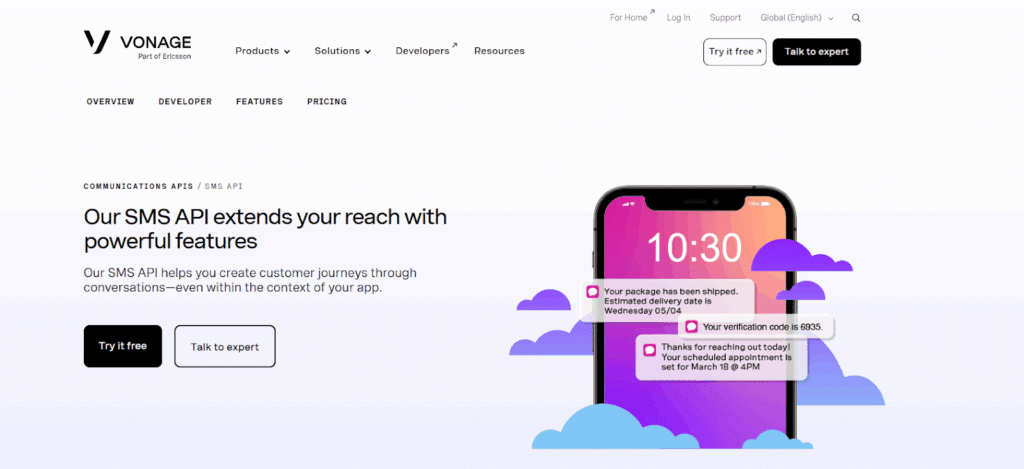
Source: vonage.com
The platform provides advanced features like real-time sentiment analysis and contact center integrations to improve client experiences. It also helps teams integrate voice messaging and manage omnichannel workflows.
On the other hand, Vonage’s platform can be more technical in setup and less intuitive for non-technical users.
Many users frequently compare it to Twilio’s price, with complaints about complexity and hidden fees. Many prefer simpler alternatives when they prioritize ease over flexibility.
3. Plivo
Plivo is a cloud-based alternative providing a suite of messaging and voice APIs geared towards enterprise use. This cloud-based communications platform spans 220+ countries and handles tens of billions of API events while offering 99.99% uptime SLAs for enterprise customers.
Plivo is HIPAA-ready and holds SOC 2 Type II and PCI DSS Level 1 certifications. It also provides pre-packaged solutions like a Verify API for user authentication and a Number Masking API for privacy. This serves as a key business requirement for enterprise clients.
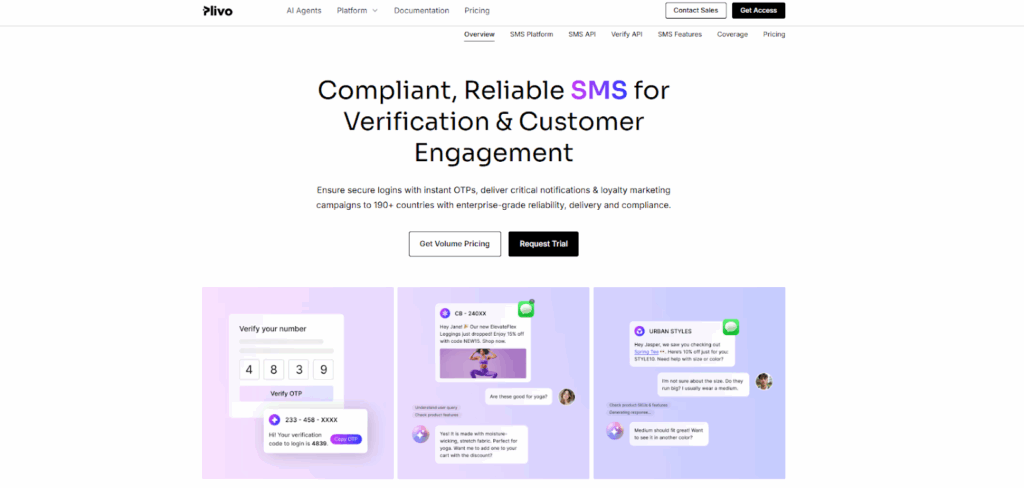
Source: plivo.com
The platform supports SMS, MMS, RCS, voice calls, and WhatsApp business API, covering the multi-channel needs of financial firms to engage clients on various platforms.
It also keeps pace with telecom regulations as it simplifies the new 10DLC registration process by handling compliance hassles.
A common complaint about Plivo is the customer support quality. Some users cite frustration with the platform’s support being slow or less hands-on after the company phased out direct phone support. For an enterprise, this could mean delays in urgent issue resolution.
Messaging deliverability issues have also been mentioned, where a handful of users faced complications with SMS delivery when carrier policies changed. This indicates that Plivo’s handling of evolving telecom rules hasn’t been completely smooth.
4. Bandwidth
Bandwidth is an enterprise communications platform with a carrier-grade feature for voice and messaging. Its services include SMS/MMS, voice calling, and emergency calling APIs, all delivered over an owned network with 5X redundant architecture for critical services.
The platform is ISO-27001-certified and SOC-2-compliant, undergoing annual audits to uphold data protection standards. They also comply with industry regulations to meet the needs of finance clients handling sensitive data.
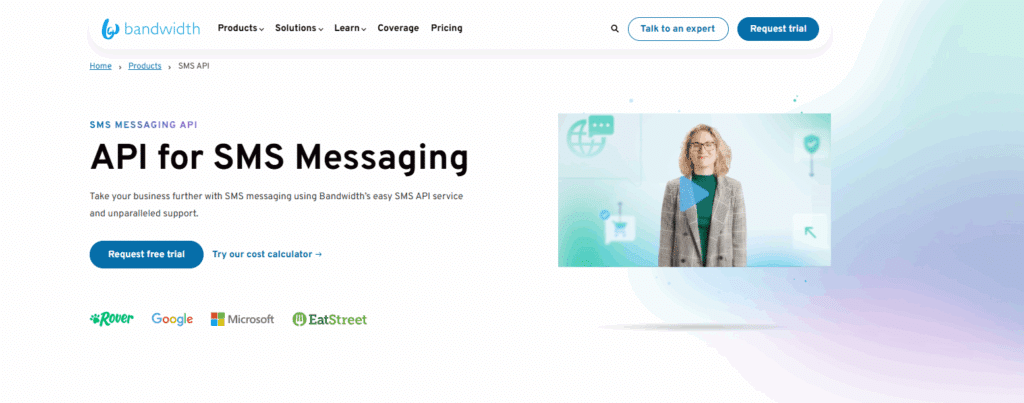
Source: bandwidth.com
Bandwidth’s network expertise shines through key features such as number management APIs and insights dashboards that provide visibility into call and message performance.
It can handle large volumes of traffic, which is crucial for time-sensitive events like one-time password bursts or critical service alerts.
But, some users mention that tasks like setting up A2P messaging campaigns or managing large volumes of numbers require navigating a clunky interface, with instances of confusing error messages and extra steps for configuration.
5. Telnyx
Telnyx is a full-stack conversational AI platform offering customizable communication APIs. This communications platform as a service (CPaaS) provider delivers customizable communication APIs underpinned by a private, global IP network.
The platform maintains SOC 2 Type II, ISO/IEC 27001:2013, ISO 27701, and PCI-DSS certifications, and is GDPR-compliant.
It’s built with a privacy-by-design philosophy, where data encryption in transit and at rest is standard, and multi-factor authentication is enforced for account access.
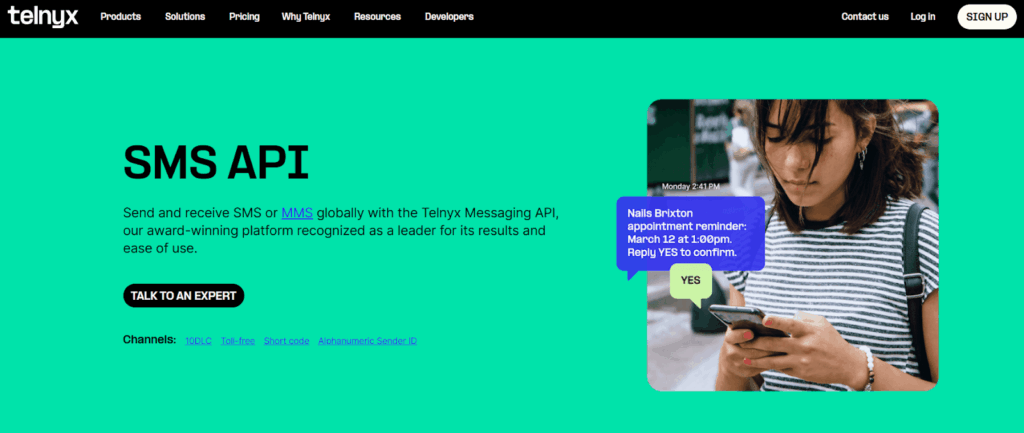
Source: telnyx.com
Telnyx supports messaging through SMS and MMS and offers a WhatsApp business API integration option. It is known for its powerful developer tools and strong documentation, which make it a good match for teams that want to automate and integrate communications.
Since Telnyx owns and optimizes its network, customers notice lower latency and higher call quality. It has self-service tools for 10DLC registration compliance, which give an easier way to register campaigns and monitor SMS throughput to stay within carrier rules.
Because it’s developer-centric, some users stated that initial onboarding and advanced configurations can be complex. In comparison, few even mentioned that Telnyx’s setup felt clunkier than Twilio’s, though support eventually helped them through it.
Should You Switch to Automated Texting?
In the world of communication tools, Textellent stands out as the best Twilio alternative that perfectly aligns with businesses prioritizing efficiency and personalization.
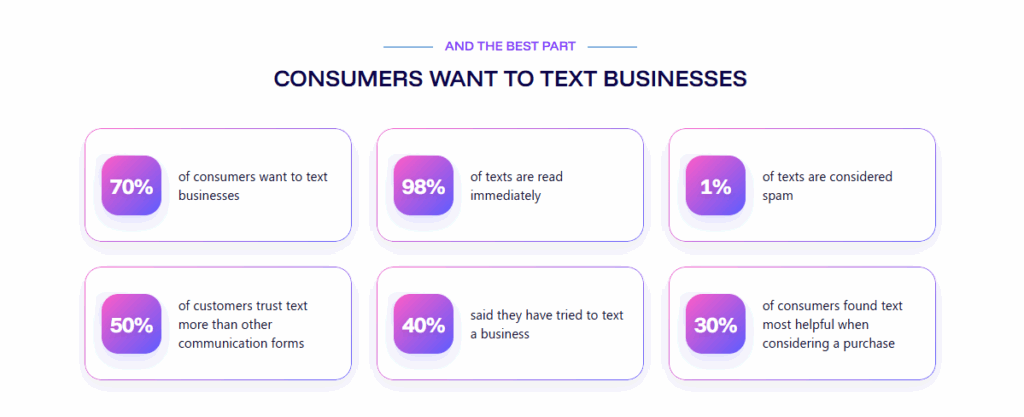
Switching to automated texting can transform how you connect, which makes customer interactions more immediate, personal, and efficient.
Unlike Twilio, which covers a broad range of communication services, Textellent focuses solely on SMS marketing. This focus means every feature specifically enhances text messaging, from targeted campaigns to efficient mass texting.
Textellent also continues to receive strong rating reviews from users who appreciate both simplicity and reliability.
If your business relies on sending a high volume of texts, Textellent’s pricing model is designed to offer more value. It guarantees you get the most out of your investment in automated texting services.
Switch From Developer Tools to Business-Ready Texting—Try Textellent!
If you’re tired of managing complex SMS APIs or juggling tools just to send a message, it’s time to switch to a platform built specifically for business texting.
When exploring alternatives, you should try Textellent. Unlike Twilio, which is built primarily for developers, this platform is made for everyday business users. You can automate campaigns, segment audiences, and track results from an intuitive dashboard.
Textellent’s built-in CRM integrations, AI message optimization, and compliance features ensure every message is aligned with your business goals.
Don’t let complexity slow your marketing strategy. Choose an SMS-based alternative to Twilio for a hassle-free way to launch impactful marketing campaigns.
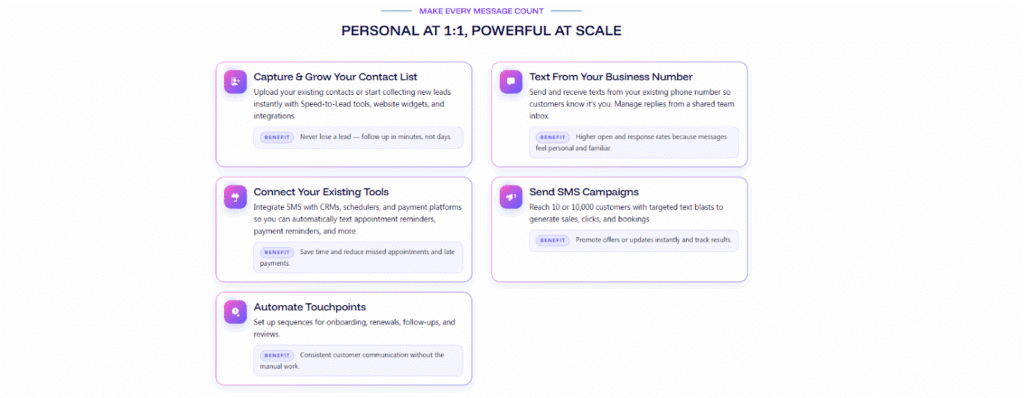
Sign up for a free trial or request a demo consultation with Textellent today!
FAQs About Twilio Alternatives
Is there an alternative to Twilio?
Zixflow, WATI, Podium, Plivo, Vonage, Sinch, Bandwidth, Infobip, and Telnyx offer powerful messaging, voice, and automation tools that rival Twilio’s flexibility.
Each alternative to Twilio is designed to provide reliability and scalability depending on your business needs. Many of these competitors offer omnichannel messaging capabilities that simplify workflows for marketing and customer service.
How do I migrate from Twilio to another service?
Migration involves exporting your data reports from Twilio, setting up your new provider, and adjusting your APIs or integrations. You need to look for platforms that simplify migration and support smooth onboarding.
If your new provider includes call forwarding, CRM syncing, or supports integrations, you’ll maintain continuity without losing data. It’s worth exploring Sinch, Bandwidth, Infobip, etc., as they offer structured onboarding assistance to reduce downtime during migration.
How do the pricing models of Twilio alternatives compare?
Pricing for messaging and communication platforms varies widely. Many providers now adopt flexible billing options, such as by user/month billed annually or by credits per month, billed annually.
You’ll also see plans like three users billed annually, or scalable structures based on users/months per line. Some platforms offer a free tier for testing so you can evaluate their features risk-free before committing to a paid plan.
But be sure to consider alternatives to Twilio that fit your specific workflow and business structure.





